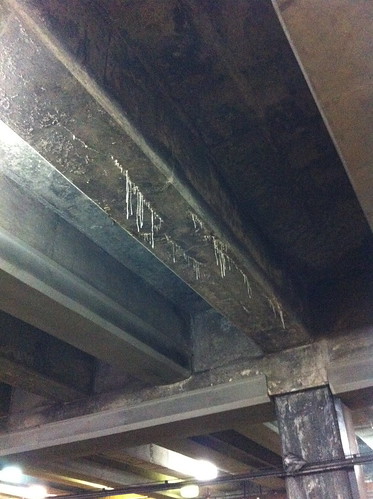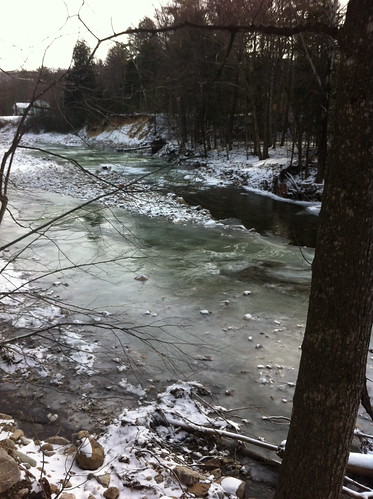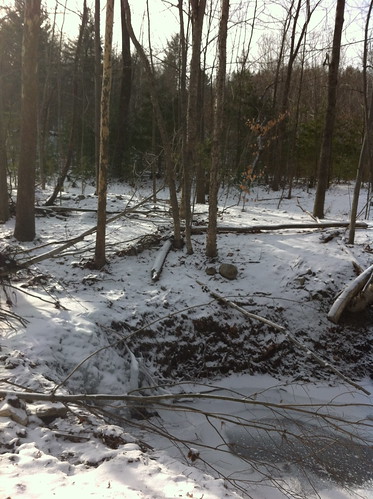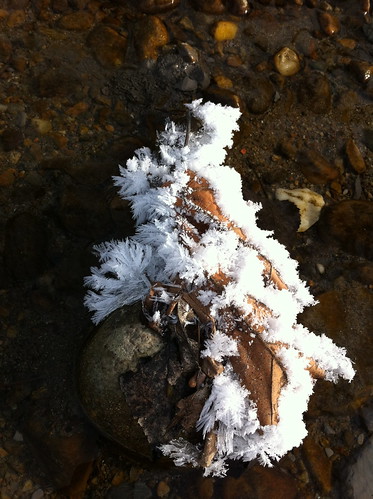I was in Boston for part of the weekend, and while temperatures weren't quite as cold as in Vermont, they felt in a sense colder. Icy air blasting through skyscrapers and over concrete have a special sort of cold to them, especially considering that this was a 'brown freeze' for Boston (there was no snow). The cold blast came right after a rainstorm, with temperatures dropping from 52F to 6F over two days, causing ice to form in unexpected places. As below-freezing temperatures seeped into the subway stations, residual rainwater found its way through ceiling cracks and created these bizarre, stalactite-like icicles.


Puddles froze over before they could dry up.

Driving back to Vermont, the roadcuts along the interstates were blanketed in dramatic ice formations that formed with the flash freeze. Unfortunately I was driving and was not able to take photos.
East Middlebury dropped below zero last night after a very cold weekend, and the Middlebury River was socked in with ice.

Ice formed anywhere water slowed down and touched a surface (or the air), leading to dramatic formations as side channels froze and were blocked. At times ice clogged up frozen up sections, leading water to flow over the ice layers.

In some places, the ice formations looked like solidified lava or the terraces of travertine springs, freezing on contact with the air and forming dramatic formations.

The imminent oxbow cut channel was mostly sealed by the ice, and had all but dried up.

Areas that were filled with floating frazil ice last week had frozen over completely.

Little 'frost flowers' formed on ice or near pockets of open water:


Also, a bit of positive news this weekend, as 18 stream gages in Vermont and northern New York that were slated for decommissioning were have been spared, for now. These stream gages are essential for obtaining sufficient warning to save lives during floods, and probably saved more than a few lives during Irene's floods. Sadly, stream gages in other parts of the country may still be decommissioned - part of a sickening move to sacrifice human lives and homes in an attempt to "shrink the government" by eradicating some of the cheapest and most effective government programs that save the most lives (see also attacks on climate forecasts used by farmers, and attempts to cut funding for hurricane, tsunami, and volcano forecasts and monitoring). This stuff is too stupid to make up... seriously. If you think sacrificing people to terrifying death by drowning or hurricane is somehow a 'necessary' step that will 'save' our country from debt or 'protect our freedoms' (to die in hurricanes and floods? I'll pass)... please see this chart and try to find the NWS or stream gages on it. Seriously.
As for Vermont's weather... well, expect more of the same. Wet snow, rain, and unseasonable thaws fluctuating with subzero temperatures and frigid mornings. This is pathetic weather for snow sports, but great weather for building up more ice formations along the river. The subzero temperatures above scant or nonexistent snowpack is also very hard on the roots of plants. It will be interesting to see how the rest of the winter plays out.

No comments:
Post a Comment